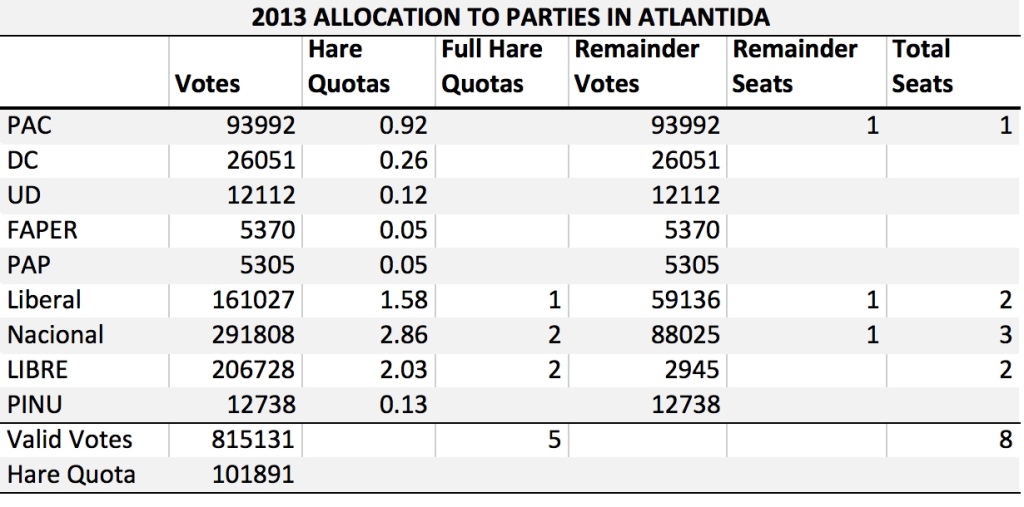Honduras has utilized four electoral systems to elect its National Congress (Congreso Nacional) since 1980.
HONDURAS 1 (1980-1), 2 (1985) & 3 (1993)
In elections from 1980 through 1993, Honduras had a fused electoral system. The same vote for a single party was used both to elect the president and to allocate seats for the National Congress.
Seats were allocated within each Honduran department utilizing the largest remainder system of proportional representation with a Hare quota. That is, seats are allocated first for full multiples of the Hare quota–votes divided by seats. Any seats not yet allocated are distributed based on largest remainders–votes not used towards a full Hare quota–with seats awarded in descending order of remainder votes until all are exhausted. Lists were closed with seats allocated to candidates in the order on the list.
Here is the apportionment of mandates to departments for elections held from 1981 through 2017:
Honduras 1, 2 and 3 are counted as separate electoral systems for two reasons. First, the expansion of the National Congress from 82 to 134 seats in 1985 constituted a significant change in constituency magnitude.
Second, Honduras switched to the double simultaneous vote (DSV), or ley de lemas, to elect the president for a single election. Parties could run more than one presidential candidate. The candidate with the most votes of the party whose candidates collectively received the most votes gained the presidency. The DSV allows a candidate to win with fewer votes than another candidate. In 1985, though Rafael Leonardo Callejas Romero (National Party) received over 200,000 votes more than José Simón Azcona del Hoyo (Liberal Party), the Liberal candidate won because the four Liberal candidates together had earned more votes than the three National candidates. Honduras reverted back to the plurality elections in 1989.
HONDURAS 4 (1997-2001)
Beginning in 1997, voters could cast separate ballots for president and deputies. Though votes for the executive and the legislature were no longer fused, the allocation method remained the same: the largest remainder system of proportional representation with a Hare quota. Lists remained closed with seats still allocated within departments.
HONDURAS 5 (2005-)
Honduras has utilized panachage to elect the National Congress since 2005. Seats remain allocated within departments.
Panachage allows a voter to cast as many votes as there are mandates within their department. Votes may vote for candidates from different parties and cannot cast more than one vote for a candidate. Voters do not vote for a party but instead must tick the boxes for each candidate that they support.
Each vote for a candidate counts towards not just the candidate’s total but also the party total. Seats are first allocated to parties based on the total of all votes for its candidates using the largest remainder system of proportional representation with a Hare quota. The candidates with the most votes within each party that received seats gain election.
The following shows the allocation process with Atlántida Department in 2013. Here is a copy of the ballot:
 In 2013, each party had 8 candidates, as Atlántida has 8 mandates. Voters did not vote for a party but could cast a single vote for up to 8 candidates and could vote for candidates from different parties. Multiple votes for a single candidate were not permitted.
In 2013, each party had 8 candidates, as Atlántida has 8 mandates. Voters did not vote for a party but could cast a single vote for up to 8 candidates and could vote for candidates from different parties. Multiple votes for a single candidate were not permitted.
The following table shows the 2013 allocation of seats to parties in Atlántida:
 The Votes column shows the total number of votes received by all of the candidates for each party. Other columns show the allocation, first for multiples of the Hare quota and then based on remainder votes. The first 5 seats were given out for full Hare quotas–1 to the Liberals, 2 to National, and 2 to LIBRE. The last 3 seats were awarded in descending order of remainder votes, first to PAC, then to National, and finally to the Liberals.
The Votes column shows the total number of votes received by all of the candidates for each party. Other columns show the allocation, first for multiples of the Hare quota and then based on remainder votes. The first 5 seats were given out for full Hare quotas–1 to the Liberals, 2 to National, and 2 to LIBRE. The last 3 seats were awarded in descending order of remainder votes, first to PAC, then to National, and finally to the Liberals.
Once the number of seats for each party had been determined, seats were allocated to candidates based on their vote totals, shown in the following table, regardless of their order on the ballot. The candidates highlighted in blue won election with the order of election shown after their names. For example, the candidate listed second on the PAC was elected because he gained more votes than the candidate listed first. The LIBRE candidate listed second won her party’s first seat because she had the most votes, though the candidate listed first also won election.
 Source: Juan Manuel Muñoz-Portillo, The rules of pork? The impact of electoral systems on legislators’ behaviour in Honduras. Dublin City University: Ph.D. Dissertation, 2013.
Source: Juan Manuel Muñoz-Portillo, The rules of pork? The impact of electoral systems on legislators’ behaviour in Honduras. Dublin City University: Ph.D. Dissertation, 2013.

